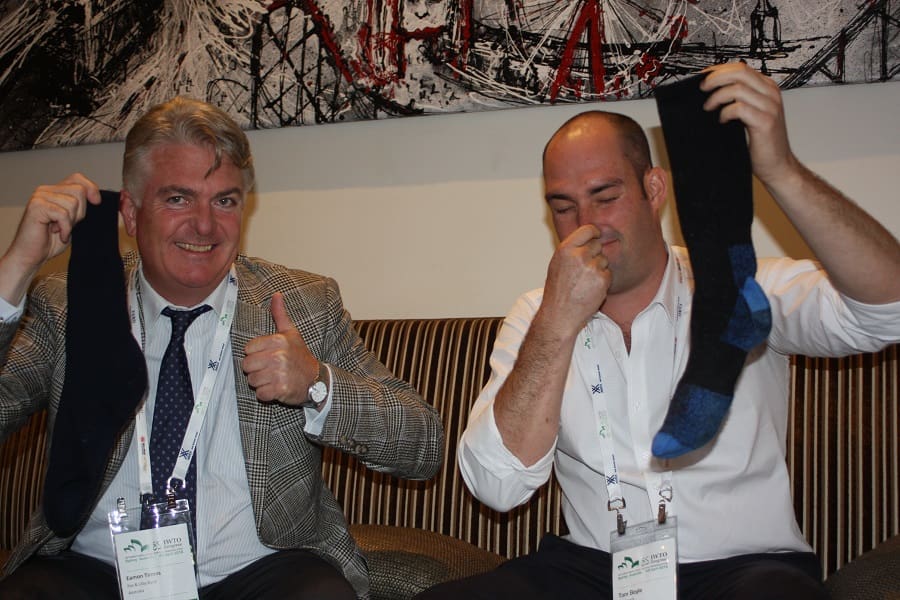
Fox and Lillie Rural’s Eamon Timms, left, likes his wool socks and Tom Boyle, left, has the other kind. Click on image for larger view.
FOX and Lillie Rural brokerage manager Eamon Timms likes the smell of his well-worn socks and recent research has backed his nose for a good news wool story.
At the recent 85th International Wool Textile Organisation Congress in Sydney, New Zealand Merino global partnership manager Dave Maslen said recent research had shown that wool garments were worn more often and washed less than clothes made of other fibres.
Eamon told the packed IWTO’s economic sustainability session he recently wore his wool socks for 14 hours a day for five consecutive days in an out of wool sheds, driving and valuing clips.
“And at the end of the fifth day maybe a very slight smell, not much at all – if it had been any other fibre they would have walked out the front door – my wife was telling me they were going to.
“If they had been cotton or some other fibre they would walked themselves to the washing machine after the third day,” he said.
“I think it is important for us to look at the great qualities that wool brings to the table in terms of environment and the fact that you can wear something like a wool sock for days and days in a row and its doesn’t smell or necessarily need to be washed as regularly as cotton and synthetics.
“What greater example have we got in what has happened in the last four days with Tesla in the US releasing their new (electric) car at a $35,000-$40,000 price point and they sold in a 24-hour period almost 200,000 cars,” Mr Timms said.
“That’s the power of what people are doing in relation to the environment these days and why wool needs to absolutely leverage off its wonderful abilities.”
Mr Timms said as Adidas executive Craig Vanderoef point out at the conference, nothing lends itself better to the ‘athleisure’ market better than wool.
“It is the perfect fibre for that massively growing market category.”
Landmark Mildura stock agent Tom Boyle said he was going home to buy a couple of pairs of wool socks to experiment.
NZ research found a key gap in wool use data
Mr Maslen said the life cycle assessment project, led by NZ Merino’s innovation and sustainability project manager Kelly McLean, to score the environmental footprint of wool from farm to disposal, looked at a pair of wool socks and a wool T-shirt right throughout the supply chain.
“We looked at the entire life cycle, so from farm all the way through to disposal – as far as we are aware that is the first time it had ever been done for wool apparel.”
The research recognised and challenged a key primary data gap in the wool use phase, he said.
“How are people using the garments, when are they using them, how are they using and washing, and at what temperature and so forth.”
The initial study used a data set that assumed the garments were going to be used once a week for one year and washed every time it is worn. But a 5-10 minute social media survey that generated more than 3500 individual responses in 48 hours found that people were wearing wool socks more often and washing them less than expected.
“Basically for (wool) socks, it told us that people are wearing their socks around 10 times a month, quite significantly different to the once a week that we were assuming – 56pc of people were getting 2-5 wears per month and per wash.
“They are not washing them every time, they are washing them every 2-5 times, that’s for a pair of socks – I’m not going to say anything else, these are outdoorsy people,” Mr Maslen said.
“What is a really interesting statistic for here and for New Zealand where there is lots of wind, is the number of people that tumble dry – it is by far and away the most popular way of drying clothes and to me that represents one of the best opportunities we have in terms of reducing our footprint.”
About half the survey respondents get two years use from wool socks
Mr Maslen said 49pc of survey respondents said they were getting more than two years active use out of their wool socks.
“It is telling us that they are lasting longer, they are wearing them more often without washing them.
“If we go to the T shirt, very similar, again 85pc are getting five-plus wears per month, 84pc of people are wearing them 2-5 times again before washing, so similar to the sock story,” he said.
“What was interesting was the amount of people who are using cold washes and similar results with regards to service life; so 66pc of people are getting more than two years active life out of those garments.
“So what that basically means is that we are wearing wool garments more often, they are lasting longer and are being washed less often than comparable products we based our original study on,” Mr Maslen.
“So what that means disappointingly, very positively, is that we have got to go and re-model our LCA.”
The new primary data would be taken to demonstrate how wool’s footprint has shifted on the basis of using more accurate information.
“What it also means is that we can take this data set and start feeding it into organisations like the Sustainable Apparel Coalition, Made-By and others to say ‘hey we’ve actually got some legitimate data here to back up what we are saying about the fact that wool has a different use phase and profile to cotton or synthetic products.
Mr Maslen believes there is a massive opportunity to tell tumble drying, consumers buying ethically-produced wool products they could have a smaller footprint if they hang dry their wool garments.
The next phase is modelling and were going out to test the data by asking active wool users to record their use. The research also piloted the new allocation methods to try to get more equity into way impact is split between meat and wool, he said.
Mr Maslen said consumer interest in sustainability and ethics was driving activist campaigns aimed at agriculture and was placing pressure on retail brands.

HAVE YOUR SAY